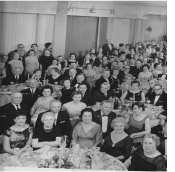This meant that prejudices against Jews (as well as Catholics, such as Irish and Italians) became less pronounced, as they were re-categorized as “White”.
Jews had had a significant presence in the arts for close to a century, but it was in the 1950’s that they rose to new levels of prominence and visibility. Novelists such as Philip Roth, Saul Bellow, Bernard Malamud and Chaim Potok openly addressed issues of American and Jewish identity, while in the new medium of television, comedians such as Jack Benny, Milton Berle and Phil Silvers were dominant. In fact, one of the first network sitcoms was The Goldbergs, starring Gertrude Berg, which made the transition from radio to television in 1949. Ironically, in their final season, the Goldbergs moved from the Bronx to the fictional suburb Haverville, at the same time that many Jews were making the same move in real life.

Suburbanization had the most profound impact on American Jews. The idea of the mass-produced suburb originated with William J. Levitt, who built the first Levittown on New York’s Long Island. People began living there in 1947. After the war, the government created a program of low cost loans for the returning soldiers and the American dream of home ownership became available to everyone.
American Jews, who until that point had been concentrated in lower-income neighborhoods in major American cities, were eager to move to these new communities. This was both an opportunity and a tremendous challenge. Although most Jews, when they moved to suburbia were not committed to giving up their Jewish identity, the pressures to become more like all other Americans was greater than ever before. As long as they lived in the cities, whether or not they were institutionally involved in Jewish life with a synagogue, or a Zionist organization, or even a Jewish socialist organization, everywhere they turned, they always met Jews. They felt a strong sense of Jewish identity, rooted in their neighborhood. This changed with the move to the suburbs. The ethos of suburbia was that all groups get along and as long as they were white and had a certain degree of affluence, they were accepted.

Jews now viewed gentiles for the first time as friends and colleagues and were involved in all sorts of communal activities such as building new public schools, firehouses, community centers. They joined non Jewish American charities and organizations, like the Red Cross, United Way and the PTA where Jews rubbed elbows with gentiles, as friends – not as neighbors in conflict, which had been the prior experience in the cities. They raised their children to see their gentile classmates not as kids to fight with in the street after school was out, but as friends who will be involved with the band, ballet and Little League. This process of assimilation became one of the greatest challenges to Jewish identity in the 20th Century.